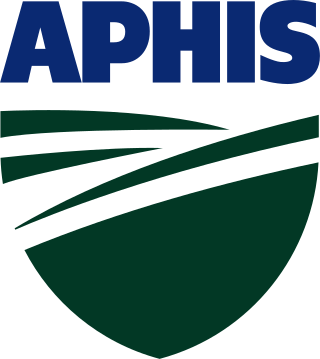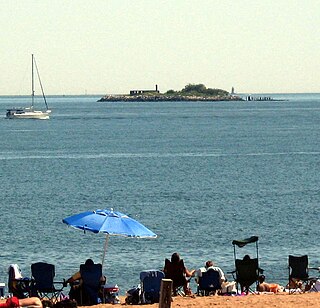
A quarantine is a restriction on the movement of people, animals, and goods which is intended to prevent the spread of disease or pests. It is often used in connection to disease and illness, preventing the movement of those who may have been exposed to a communicable disease, yet do not have a confirmed medical diagnosis. It is distinct from medical isolation, in which those confirmed to be infected with a communicable disease are isolated from the healthy population.

The United States Public Health Service is a collection of agencies of the Department of Health and Human Services concerned with public health, containing nine out of the department's twelve operating divisions. The Assistant Secretary for Health oversees the PHS. The Public Health Service Commissioned Corps (PHSCC) is the federal uniformed service of the PHS, and is one of the eight uniformed services of the United States.

The Animal and Plant Health Inspection Service (APHIS) is an agency of the United States Department of Agriculture (USDA) based in Riverdale, Maryland responsible for protecting animal health, animal welfare, and plant health. APHIS is the lead agency for collaboration with other agencies to protect U.S. agriculture from invasive pests and diseases. APHIS's PPQ is the National Plant Protection Organization for the U.S., and the agency's head of veterinary services/veterinary Deputy Administrator is the Chief Veterinary Officer of the United States.

John Maynard Woodworth was an American physician and member of the Woodworth political family. He served as the first Supervising-Surgeon General under president Ulysses S. Grant, then changed to Surgeon General of the United States Marine Hospital Service from 1871 to 1879.

The Marine Hospital Service was an organization of Marine Hospitals dedicated to the care of ill and disabled seamen in the United States Merchant Marine, the U.S. Coast Guard and other federal beneficiaries. The Marine Hospital Service evolved into the U.S. Public Health Service.

John Brown Hamilton was an American physician and soldier. He was appointed the second Surgeon General of the United States from 1879 to 1891.

Walter Wyman was an American physician and soldier. He was appointed the third Surgeon General of the United States from 1891 until his death in 1911.

Hoffman Island is an 11-acre (4.5 ha) artificial island in the Lower New York Bay, off the South Beach of Staten Island, New York City. A smaller, 4-acre (1.6 ha) artificial island, Swinburne Island, lies immediately to the south. Created in 1873 upon the Orchard Shoal by the addition of land fill, the island is named for former New York City mayor (1866–1868) and New York Governor (1869–1871) John Thompson Hoffman.

Swinburne Island is a 4-acre (1.6 ha) artificial island in Lower New York Bay, east of Staten Island in New York City. It was used for quarantine of immigrants. Swinburne Island is the smaller of two nearby islands, the other being Hoffman Island to the north.

The Steamboat Inspection Service was a United States agency created in 1871 to safeguard lives and property at sea. It merged with the Bureau of Navigation in 1932 to form the Bureau of Navigation and Steamboat Inspection, which in 1936 was reorganized into the Bureau of Marine Inspection and Navigation. The Bureau of Marine Inspection and Navigation's responsibilities were transferred temporarily to the United States Coast Guard in 1942. The Bureau was abolished in 1946, when its functions were transferred permanently to the Coast Guard.

The Philadelphia Lazaretto was the Second quarantine hospital in the United States, built in 1799, in Tinicum Township, Delaware County, Pennsylvania. The site was originally inhabited by the Lenni Lenape, and then the first Swedish settlers. Nearby Province Island was the site of the confinement of the Christian Moravian Indians who were brought there under protective custody from Lancaster, Pennsylvania, in 1763 when their lives were threatened by the Paxton Boys. The facility predates similar national landmarks such as Ellis Island Immigrant Hospital and Angel Island and is considered both the oldest surviving quarantine hospital and the last surviving example of its type in the U.S.
Compagnie Francaise de Navigation a Vapeur v. Louisiana Board of Health, 186 U.S. 380 (1902), was a United States Supreme Court case which held constitutional state laws requiring the involuntary quarantine of individuals to prevent the spread of disease. Louisiana's quarantine laws, Justice Edward White said, were a reasonable exercise of the state's police power that conflicted with neither the Dormant Commerce Clause nor the Due Process Clause of the Fourteenth Amendment. In dissent, Justice Henry Billings Brown, joined by John Marshall Harlan, agreed that while quarantine laws were constitutional, Louisiana's went beyond the scope of the state's authority over interstate commerce, even violating several treaties between the United States and other nations.

Joseph James Kinyoun was an American physician and the founder of the United States' Hygienic Laboratory, the predecessor of the National Institutes of Health.

The San Francisco plague of 1900–1904 was an epidemic of bubonic plague centered on San Francisco's Chinatown. It was the first plague epidemic in the continental United States. The epidemic was recognized by medical authorities in March 1900, but its existence was denied for more than two years by California's Republican governor Henry Gage. His denial was based on business reasons, to protect the reputations of San Francisco and California and to prevent the loss of revenue due to quarantine. The failure to act quickly may have allowed the disease to establish itself among local animal populations. Federal authorities worked to prove that there was a major health problem, and they isolated the affected area; this undermined Gage's credibility, and he lost the governorship in the 1902 elections. The new governor, George Pardee, implemented public-health measures and the epidemic was stopped in 1904. There were 121 cases identified, resulting in 119 deaths.

The Carriage of Passengers Act of 1855 was an act passed by the United States federal government on March 3, 1855, replacing the previous Steerage Act of 1819 and a number of acts passed between 1847 and 1849 with new regulations on the conditions of sea transportation used by passenger ships landing in the United States. The law was passed by the 33rd United States Congress and signed into law by President Franklin Pierce.
This is a timeline of the United States Public Health Service Commissioned Corps and its predecessor, the Marine Hospital Service.
The National Board of Health (NBH) was a short lived institution that operated from 1879 to 1883 in the United States. It was created during the third Session of the 45th Congress, listed as chapter 202 better known as the Public Health Act of 1879. The purpose of the NBH was to carry out a piece of legislation passed in Session I of the 45th Congress, Chapter 66. Chapter 66 and Chapter 202 were redundant pieces of legislature in all aspects but one: the implementation and oversight of the NBH.

The Passenger Act of 1882 is a United States federal statute establishing occupancy control regulations for seafaring passenger ships completing Atlantic and Pacific transoceanic crossings to America during the late 19th century and early 20th century. The Act of Congress sanctioned vessel compartment dimensions in cubic feet comparable to the level within a ship's deck. The public law authorized the numerical serialization of berths which were subject to compartment occupancy inspections of emigrants and ocean liner passengers. The Law of the United States accentuated and endorsed a regulatory clause stating no person, on arrival of a vessel in a port, will be allowed to go aboard a passenger ship necessitating a bow to stern inspection.

The Division of Global Migration Health (DGMH), formerly the Division of Global Migration and Quarantine is the part of the U.S. government responsible for U.S. Quarantine Stations and issuing quarantine orders. It is part of the National Center for Emerging and Zoonotic Infectious Diseases within the Centers for Disease Control and Prevention (CDC).

Public Health Act of 1879 or National Board of Health Act, 1879 was a United States federal statute authorizing the creation of the National Board of Health. The Act of Congress was an appeal for a national public health organization and national quarantine system for purposes of contagious or infectious diseases discovered in nineteenth century America. The United States public law sanctioned the newly formed National Health Board and Academy of Sciences to provide reports concerning public health information with regards to the Perpetual Union or States for the purposes of;















